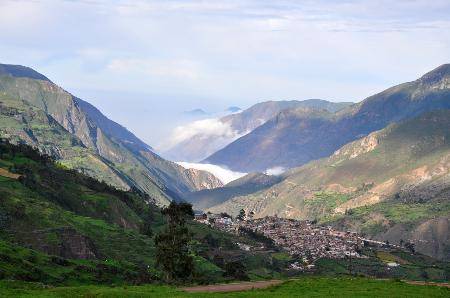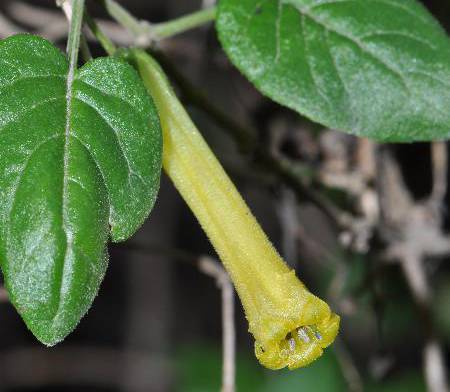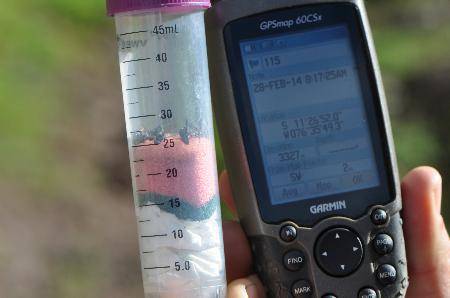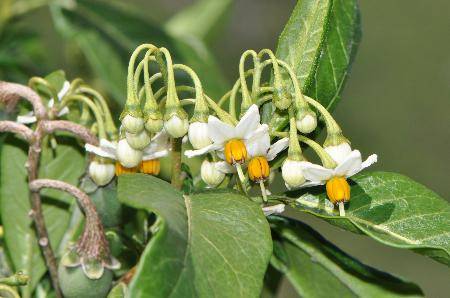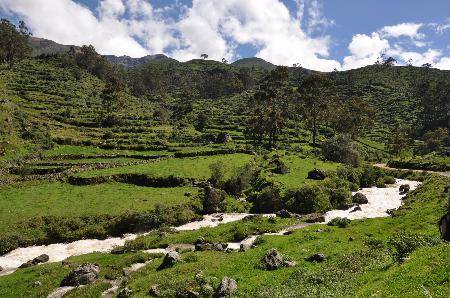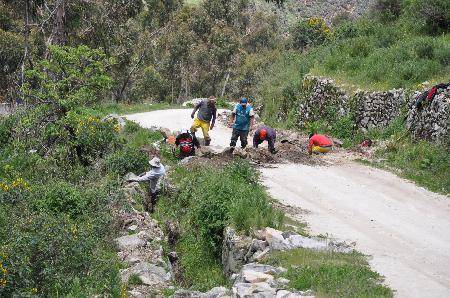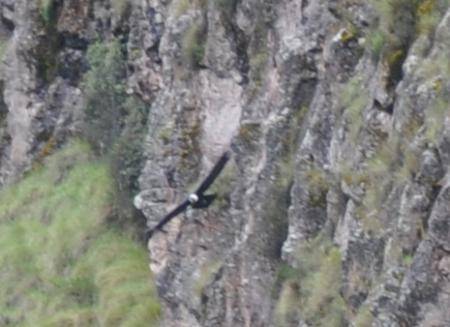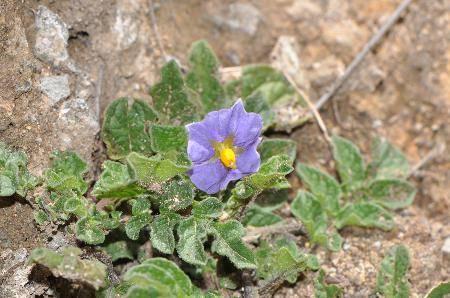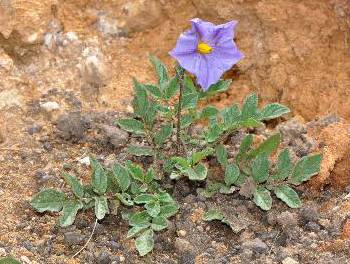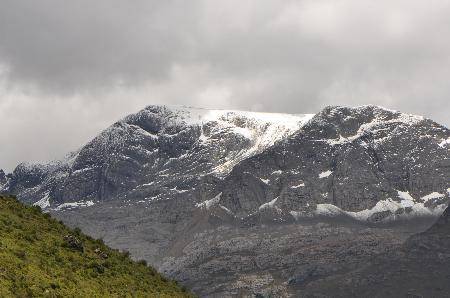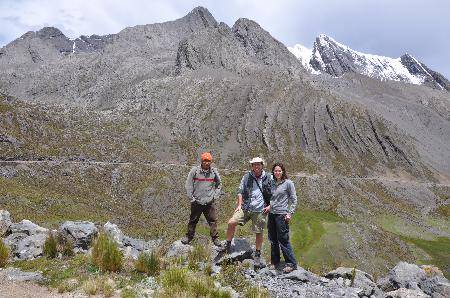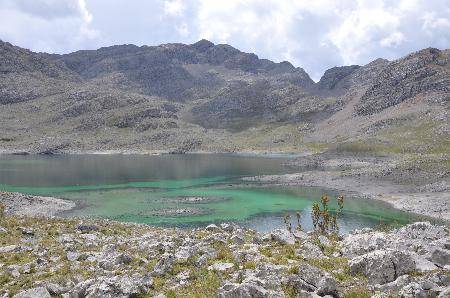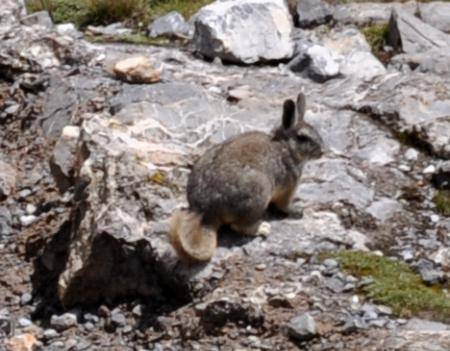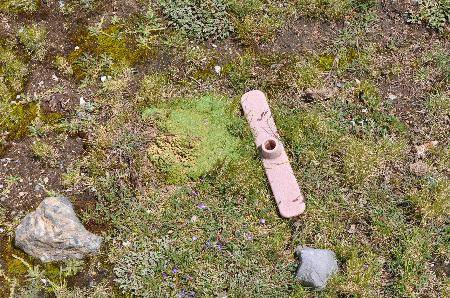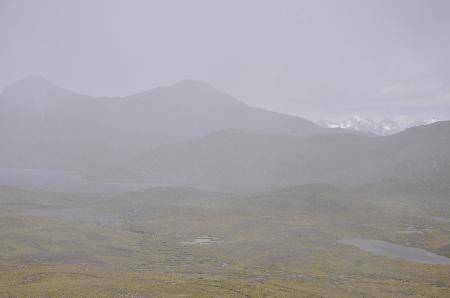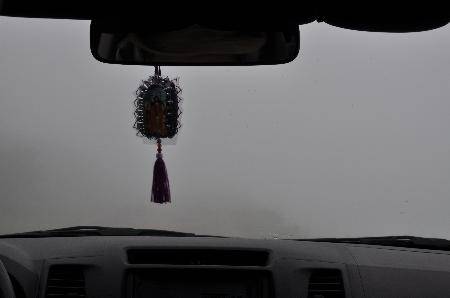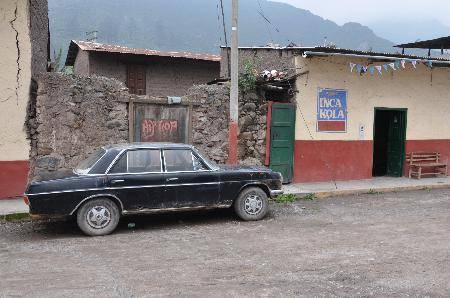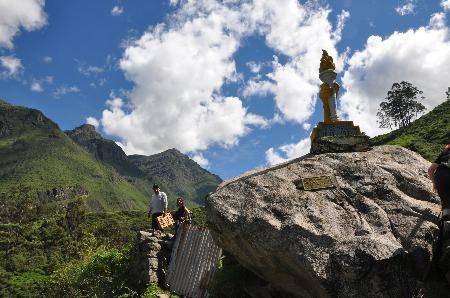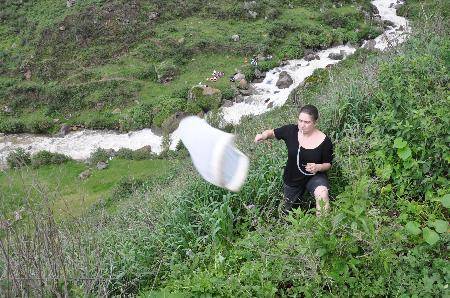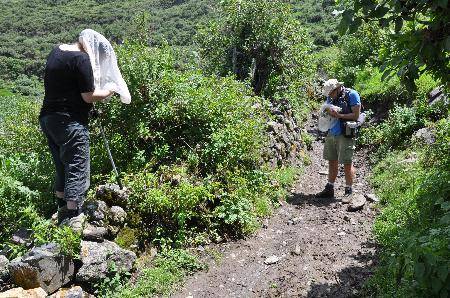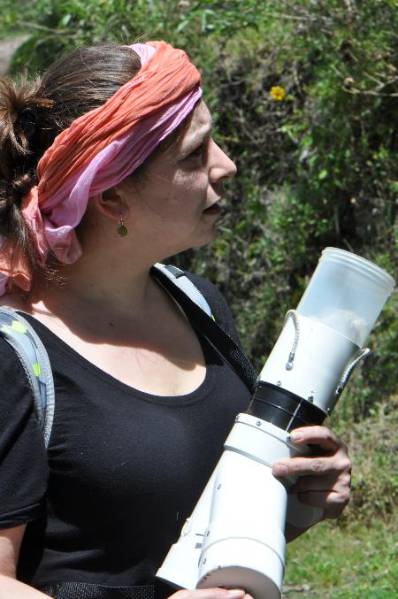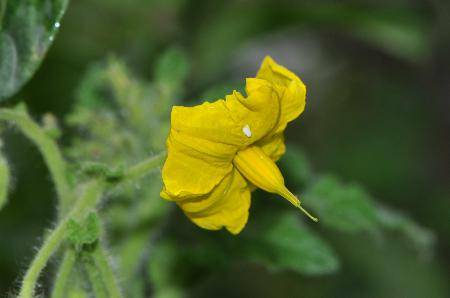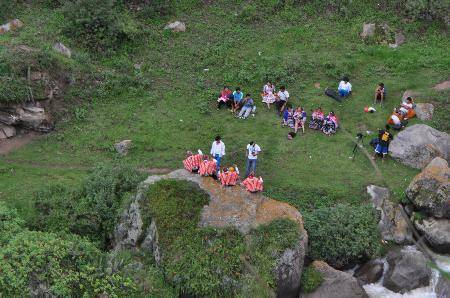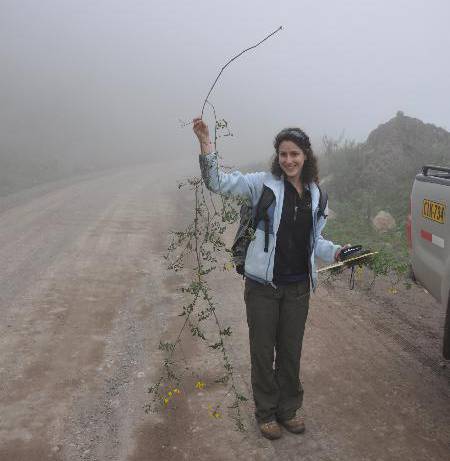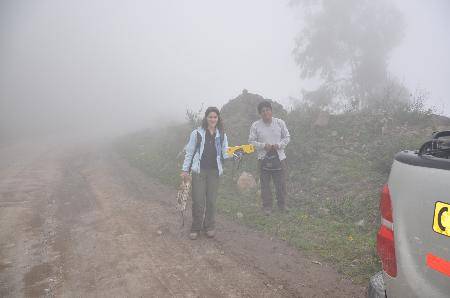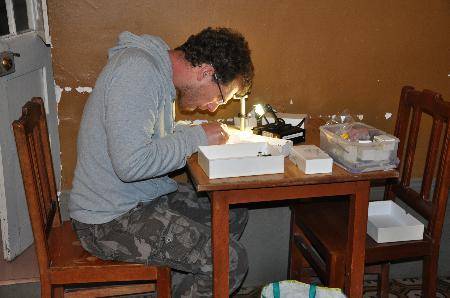From Canta, a road goes up the Río Chillon to Cerro de Pasco and the eastern side of the Andes – crossing over the high elevation grassland habitat called the puna. Several wild potatoes grow in these extreme habitats above or around 4,000 metres elevation – these were our targets for the day. We leave the tomatoes behind for the day - none grow this high!
Looking back down the valley we saw Canta perched on its hill, plus the line of dusty, smoggy air from Lima and the coast... we were pleased to be up in the fresh air!
As we climbed up the switchbacks (ubiquitious in the Andes) we spotted our first Solanaceae of the day – and it was a new distribution record for the valley…
Salpichroa microloba is endemic to central Peru but had never before been collected in this valley – Paul was excited – this genus is the topic of his Master’s thesis. He also managed to spot a hummingbird visiting the flowers…
A colleague had told us that the diversity of insects above 1,000 metres elevation was poor – so here is a photo of the GPS (registering 3,327m elevation) and vial of insects to prove the point. Insect life teems at high elevations, and it is usually interesting and often endemic.
Further up the valley opened out, and the Río Chillon rushed through – along the banks we found Solanum amblophyllum, previously thought to be an endemic of Lima department, but recently found in neighbouring Ancash by our colleague from the Museo, Asunción Cano.
Solanum amblophyllum is a member of the Geminata clade that I revised last in 2008 – there are several new species to describe (I wrote about some of these from Brazil last year), but it is great to see ones that I recognise in the field. It was VERY common along the river amongst boulders and grass…
The Río Chillon is a typical mountain river, crashing through gorges and with extremely rapid flow. Along the banks we saw Andean torrent ducks – two males posturing to each other… the female was being swept downstream (apparently, although she was probably completely under control) and the males seemed too busy to notice.
We had a forced stop at the small village of Cullhuay where pipes were being installed – we had to wait about half an hour then drive across a ditch over two very narrow planks – Dan was the driver for the day and he managed with great aplomb.
Putting in the pipes involves a lot of manual labour – pipes in lengths of 5-8 metres being carried from the village below (by hand of course) and a lot of shovel work, but by the time we came down they were done and the ditch was all filled in!
Cullhauy was the last village on the road, further up there were only isolated houses and stone corrals where livestock are kept overnight. The whole grassy area operates like a common, where local people take their cattle or llamas out for the day to graze and then bring them back at night to protect them from pumas. Other exciting wildlife exists in these high mountains as well – much to our excitement we saw a huge bird circling the valley – an Andean condor – as big as the cattle on the slopes! So amazing – I have been to Peru many times and have never seen a condor there before…
The picture is a bit fuzzy (sorry about that but it was a long way away across the valley) but the white collar and huge wingspan is unmistakeable – it was HUGE.
About where we saw the condor we found populations of our target potato species – so had a nice long collecting stop. The sun was still out so the insects were plentiful and Erica found that the aspirator worked a treat on the small, flat rosettes of these high elevation species. We were near the treeline, although the trees were long gone, mostly cut for firewood. These areas were at one time probably forested with small patches of Polylepis (a member of the rose family) woodland in sheltered valleys – very few of these forest patches remain in these populated valleys.
Solanum acaule is a relatively common potato species at these high elevations – we have collected it before in southern Peru; the leaves hug tightly to the ground and the tiny flowers have big, bright green stigmas.
We are not quite sure what species this is – the flowers are much bigger than those of Solanum acaule, and the leaves are different as well. When collecting it is important to keep things you think are different apart, even if they turn out to be the same in the end. This one is a different species though… I am sending a photo (and later the specimen) to my colleague David Spooner in Wisconsin to see if he can help!
Further up the road, the mountains proper began to show themselves – this range is called the Cordillera de la Viuda (Window’s Range - the name makes you wonder...) and the tallest peaks are all above 5,000 metres in elevation (the tallest, Rajuntay, is 5,475 m).
Cordillera de la Viuda - this range extends for about 50 miles and has several very tall peaks that are permanently snow-covered.
This high up there is little vegetation over a few centimetres tall, the plants are either grasses, or small and hugging the ground as rosettes or hidden in the shelter of rocks. The lack of vegetation cover allows one to really appreciate the complex and totally breath-taking geology of the Andes. The Andean mountain range is the result of the subduction of the Pacific plate under the continental margin and was pushed up and crumpled over the course of millions of years. The southern Andes are older than the ranges to the north – in Canta we were about in the middle. The range is between 10-30 million years old, relatively young in geological terms.
Driving along high mountain roads you can pass sections that are crumpled one way, then around the corner, other sections going in the opposite direction – this really brings home the dynamic and ever-changing nature of the earth we live on – it is not static and unchanging in the least!
Paul, Dan and Mindy with nearly vertical strata behind…
The scenery in these high elevation habitats is not to be believed – I love the jungle and the dense forest, but the sense of space and openness at high elevation is special. At this point we were about 4,700 metres above sea level – the air is pretty thin up that high so running about is not to be recommended.
The region in the Cordillera de la Viuda is peppered with tiny (and not so tiny) lakes with the most extraordinary colours and perfectly clear water.
We were lucky to see viscachas – a lagomorph (rabbit relative) endemic to South America. This species is the northern viscachaLagidium peruanum) – known only from these high elevation habitats from central Peru to northern Chile. They look a bit like giant kangaroo rats, or gerbils. Again, like the condor, this picture is a bit fuzzy, they were hard to get close to!
Sadly, even along this remote road you can still find the traces of humans – not just archeological remains, but more prosaic garbage. What in heaven’s name is a broom head doing far from the road amongst the cushion plants? In this climate it will be there for a long, long time…
The road climbed ever higher, but at about 4,800 metres it flattened out and began to go down – we decided to turn back – it was rumbling with thunder and began to hail. Erica and Dan had enough insects to keep them busy for hours and hours…
The “pass” was more like a broad flat area; llamas and alpacas were grazing here, it was a bit high for cattle.
The hail on the top was a portent of things to come. The valley on the way back down was completely under cloud – in fact, it felt like we were IN the cloud, which I suppose we were in fact. At times the road wasn’t really visible, good job there was absolutely no traffic.
The road was dirt and usually a single lane with drop-offs on one side and cliffs on the other, so the lack of traffic was actually a good thing. This is the view of the road (you can see it, can't you?) from the front seat. We saw several rock slides that I don’t remember from the way up… our mascot (San Martin de Porres I think) was clearly helping...
Back at the Hostal Santa Catalina Erica and Dan had several hours of insect prep to do, Paul, Mindy and I had the plants to prepare and put on the dryer – so we had a busy last evening in Canta. Tomorrow I return to Lima to fly out the next day back to London – the rest of the team is headed into the next valley north to go up again. That is travel in the Andes for you; up and down, up and down. They will drop me off on the Panamerican Highway near the coast and I will catch a bus or taxi back into Lima.
I wish I were going with them...



